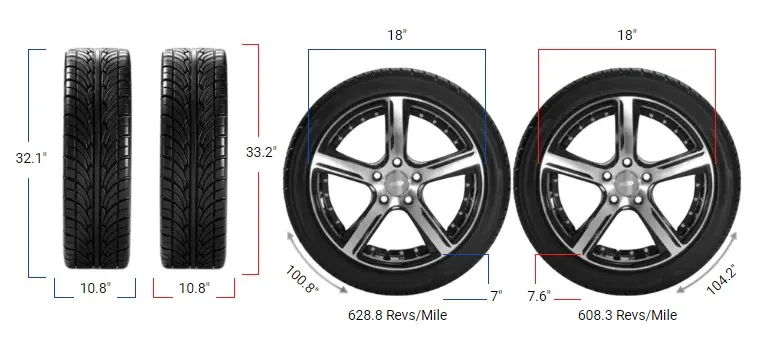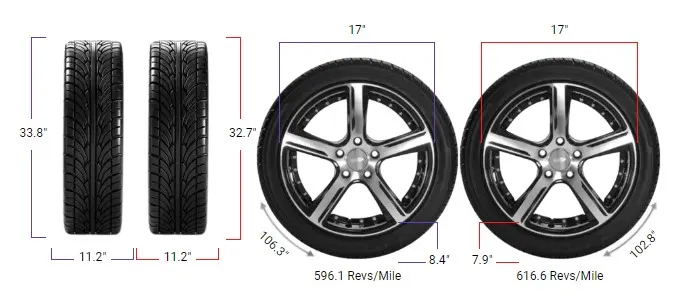Tire Size 235/80r17 vs 285/70r17
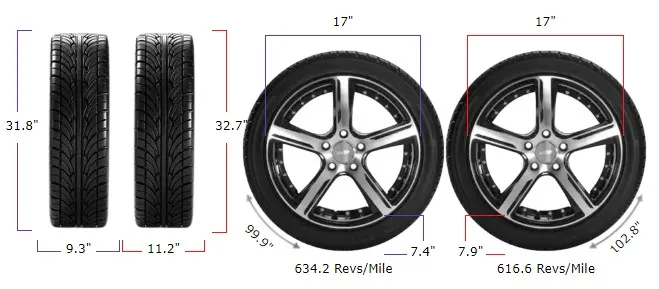
Thinking about changing your tires? Let’s explore what happens when you switch from 235/80r17 to 285/70r17. This guide will help you understand the effects on your vehicle, both on and off the road.
- Increased ground clearance improves obstacle navigation
- Wider tires enhance traction on various surfaces
- More aggressive appearance boosts vehicle aesthetics
- Firmer ride may lead to a less comfortable driving experience
- Reduced fuel efficiency due to increased rolling resistance
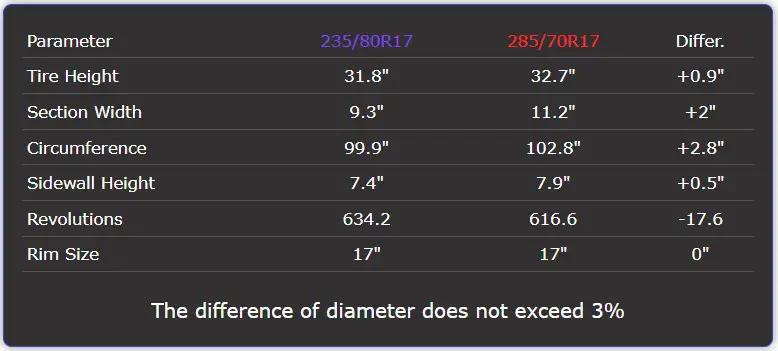
Fitment Guide
Replacement tires should be within 3% of the original tire’s diameter to maintain proper vehicle function.
The diameter difference between these two sizes is 2.8%, which is within the acceptable range. Therefore, switching from 235/80r17 to 285/70r17 is generally acceptable.
On-Road Impact
Switching tire sizes can affect how your vehicle behaves on the road. A larger and wider tire can change the driving experience in several ways. Let’s dive into the on-road impacts of moving to a wider tire.
Ground Clearance
With a slightly larger diameter, the 285/70r17 tires increase your vehicle’s ground clearance by about 0.45 inches (11.5 mm) per side.
This means the vehicle sits higher off the ground, which can help you clear speed bumps and other minor obstacles more easily.

Gas Mileage
Wider tires create more rolling resistance because more rubber contacts the road. This increased friction can lower your fuel efficiency.
While the change might not be drastic, you may notice a slight decrease in gas mileage over time.
Aesthetic Look
The wider 285/70r17 tires give your vehicle a more aggressive and robust appearance.
The increased width fills out the wheel wells more completely, enhancing the visual appeal. For many drivers, this aesthetic upgrade is a significant benefit.
Ride Comfort
Broader tires can offer better grip but may also result in a firmer ride. The stiffer sidewalls of wider tires transmit more road imperfections to the cabin.
You might feel bumps and potholes more than before, which can affect ride comfort.
Speedometer Accuracy
Due to the larger circumference of the 285/70r17 tires, your speedometer may read slightly lower than your actual speed.
For example, when it shows 20 mph, you’re actually going 20.57 mph. This is a minor difference but could have implications for speed limits and traffic enforcement.

Handling
Wider tires can improve cornering grip because of the increased contact patch. This can enhance handling, especially during high-speed maneuvers. However, the steering might feel heavier, and the vehicle may be less responsive at lower speeds.
Durability & Wear
Wider tires distribute the vehicle’s weight over a larger area, potentially reducing tread wear. This can extend the life of the tires.
However, the increased surface area is also more exposed to road debris, which could lead to a higher risk of punctures or cuts.
Off-Road Impact
For off-road enthusiasts, tire size can make a big difference. Larger and wider tires can improve performance on rough terrain. Let’s see how switching to 285/70r17 tires affects your off-road adventures.
Ground Clearance
The increase in ground clearance helps you navigate rough terrain more easily. Obstacles like rocks, logs, and uneven ground become less of a challenge, reducing the risk of undercarriage damage.
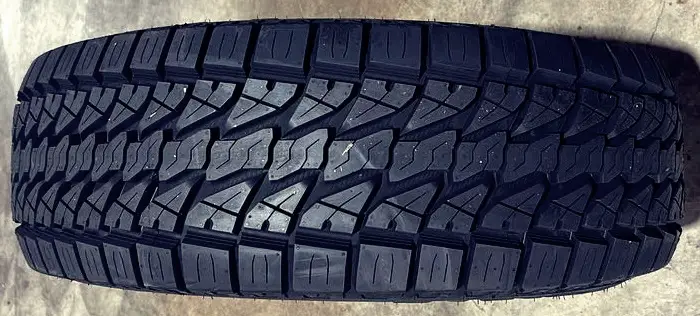
Traction
The wider tires provide a larger contact patch with the ground, enhancing traction on loose surfaces like mud, sand, and gravel. This can prevent you from getting stuck and improve your ability to climb steep inclines.
Handling
Broader tires can improve stability off-road, making your vehicle feel more planted. The wider footprint helps distribute the vehicle’s weight more evenly, which can be beneficial when traversing uneven terrain.
Ride Comfort
Off-road, the firmer ride of wider tires can actually be an advantage. The stiffer sidewalls can reduce the risk of tire damage from sharp rocks or other obstacles. However, the ride may feel bumpier compared to narrower tires.
Durability & Wear
Off-road conditions are tough on tires. The increased width may make the 285/70r17 tires more susceptible to cuts or punctures from sharp objects. However, the thicker sidewalls often found on off-road tires can help mitigate this risk.
235/80r17 vs 285/70r17
| Feature | 235/80R17 | 285/70R17 | Difference |
|---|---|---|---|
| Diameter inches (mm) | 31.8 (807.8) | 32.71 (830.8) | 0.91 (23) 2.8% |
| Width inches (mm) | 9.25 (235) | 11.22 (285) | 1.97 (50) 21.3% |
| Circumference inches (mm) | 99.91 (2537.78) | 102.76 (2610.04) | 2.84 (72.26) 2.8% |
| Sidewall Height inches (mm) | 7.4 (188) | 7.85 (199.5) | 0.45 (11.5) 6.1% |
| Revolutions per mile (km) | 634.15 (394.04) | 616.6 (383.14) | -17.56 (-10.91) -2.8% |
| Speedo Reading | 20 mph (32.19 km/h) | 20.57 mph (33.1 km/h) | +0.57 mph |
Difference Between 235/80R17 and 285/70R17?
The main difference between the 235/80r17 and 285/70r17 tires is the width and diameter. The 285/70r17 tires are wider by 1.97 inches (50 mm), a 21.3% increase.
The diameter is also larger by 0.91 inches (23 mm), which is a 2.8% increase. These changes impact your vehicle’s performance in several ways.
Can I Use 285/70R17 Instead of 235/80R17?
Yes, you can use 285/70R17 tires as they fall within the acceptable diameter difference of 3%. However, ensure your vehicle can accommodate the wider size.
How Much Taller Is a 285/70R17 Tire Than a 235/80R17?
A 285/70R17 tire is approximately 0.91 inches taller than a 235/80R17 tire, offering slightly increased ground clearance for improved off-road capability.
How Much Wider Is a 285/70R17 Tire Than a 235/80R17?
The 285/70R17 tire is about 1.97 inches wider than the 235/80R17, providing a larger contact patch for better traction and stability on the road
Our Observation
Switching from 235/80r17 to 285/70r17 tires offers both benefits and drawbacks. On the positive side, you gain increased ground clearance, improved off-road traction, and a more aggressive look that many drivers appreciate.
The wider tires can enhance handling in certain conditions and may extend tire life due to reduced tread wear. However, there are some downsides to consider. You might experience a slight drop in fuel efficiency due to increased rolling resistance.
The ride may become firmer, affecting comfort on long drives. The speedometer will read slightly lower than your actual speed, but this difference is generally negligible.
Additionally, wider tires may require adjustments to prevent rubbing against the wheel wells, especially during sharp turns or when the suspension is compressed.
For off-road use, the benefits are more pronounced, making the switch worthwhile for enthusiasts who frequently tackle challenging terrains.
On-road, the differences are subtle, and the impact on daily driving is minimal for most users. Before making the change, ensure that your vehicle can accommodate the increased width without causing rubbing or clearance issues.
Overall, if you’re seeking better off-road performance and don’t mind minor changes in on-road dynamics, switching to 285/70r17 tires is a good option.


